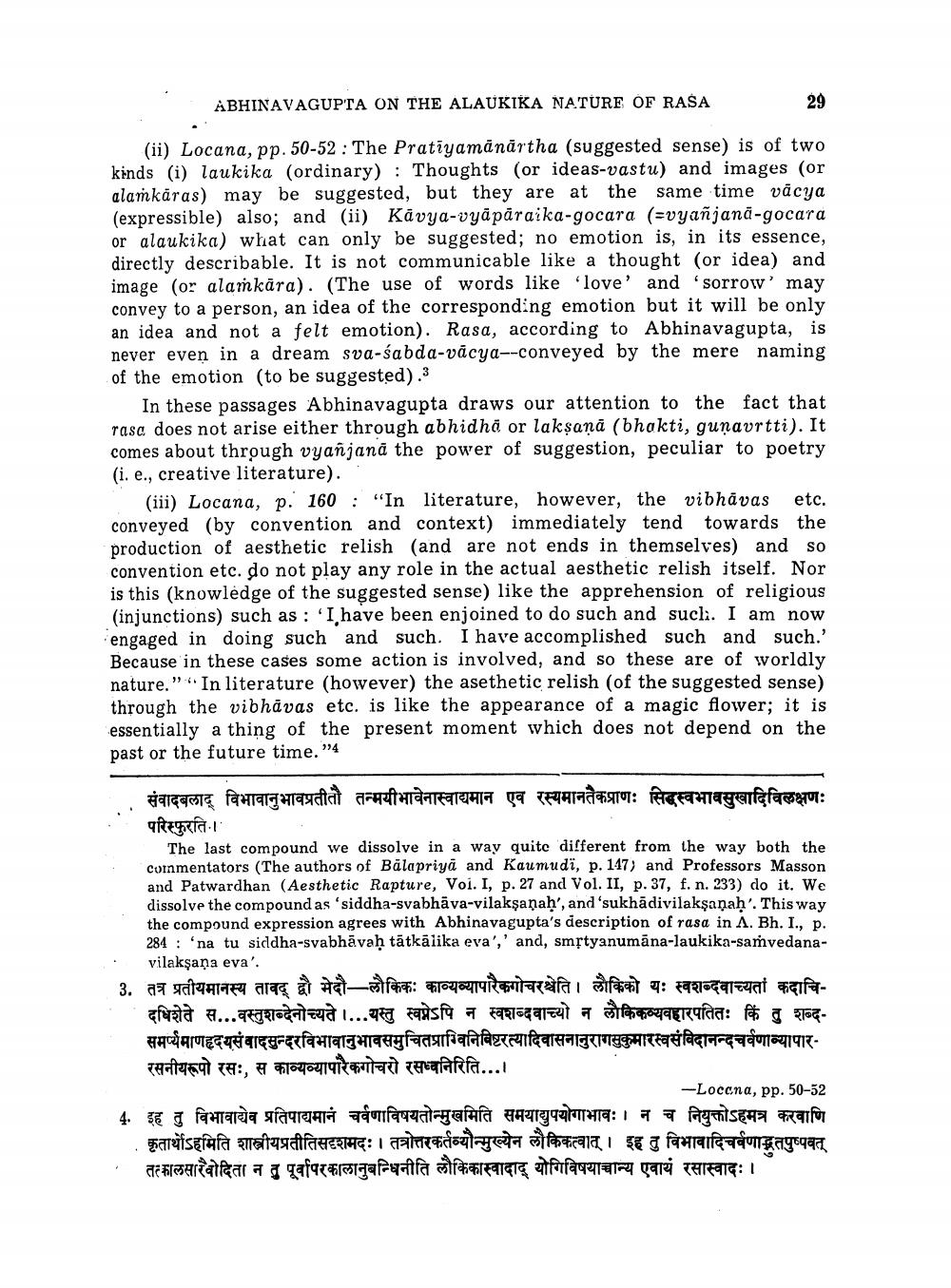________________
ABHINAVAGUPTA ON THE ALAUKIKA NATURE OF RASA
29
(ii) Locana, pp. 50-52 : The Pratiyamānārtha (suggested sense) is of two kinds (i) laukika (ordinary) : Thoughts (or ideas-vastu) and images (or alamkāras) may be suggested, but they are at the same time vācya (expressible) also; and (ii) Kavya-vyāpāraika-gocara (=vyañjana-gocara or alaukika) what can only be suggested; no emotion is, in its essence, directly describable. It is not communicable like a thought (or idea) and image (or alamkara). (The use of words like 'love' and 'sorrow' may convey to a person, an idea of the corresponding emotion but it will be only an idea and not a felt emotion). Rasa, according to Abhinavagupta, is never even in a dream sva-sabda-vācya--conveyed by the mere naming of the emotion (to be suggested).3
In these passages Abhinavagupta draws our attention to the fact that rasc does not arise either through abhidha or laksaņā (bhakti, guņavrtti). It comes about through vyañjana the power of suggestion, peculiar to poetry (i. e., creative literature).
(iii) Locana, p. 160: "In literature, however, the vibhāvas etc. conveyed (by convention and context) immediately tend towards the production of aesthetic relish (and are not ends in themselves) and so convention etc. do not play any role in the actual aesthetic relish itself. Nor is this (knowledge of the suggested sense) like the apprehension of religious (injunctions) such as : 'I have been enjoined to do such and such. I am now engaged in doing such and such. I have accomplished such and such.' Because in these cases some action is involved, and so these are of worldly nature." In literature (however) the asethetic relish (of the suggested sense) through the vibhāvas etc. is like the appearance of a magic flower; it is essentially a thing of the present moment which does not depend on the past or the future time."4
संवादबलाद् विभावानुभावप्रतीतौ तन्मयीभावेनास्वाद्यमान एव रस्यमानतैकप्राणः सिद्धस्वभावसुखादिविलक्षणः परिस्फुरति।
The last compound we dissolve in a way quite different from the way both the Coinmentators (The authors of Balapriya and Kaumudi, p. 147) and Professors Masson and Patwardhan (Aesthetic Rapture, Vol. I, p. 27 and Vol. II, p. 37, f. n. 233) do it. We dissolve the compound as 'siddha-svabhāva-vilaksanah', and 'sukhādivilaksanah'. This way the compound expression agrees with Abhinavagupta's description of rasa in A. Bh. I., P. 284 : 'na tu siddha-svabhävah tätkālika eva',' and, smrtyanumăna-laukika-saṁvedanavilaksaņa eva'. तत्र प्रतीयमानस्य तावद् द्वौ मेदौ-लौकिकः काव्यव्यापारैकगोचरश्चेति। लौकिको यः स्वशब्दवाच्यता कदाचिदधिशेते स...वस्तुशब्देनोच्यते।...यस्तु स्वप्नेऽपि न स्वशब्दवाच्यो न लौकिकव्यवहारपतितः किं तु शब्दसमर्प्यमाणहृदयसंवादसुन्दरविभावानुभावसमुचितप्राग्विनिविष्टरत्यादिवासनानुरागसुकुमारस्वसंविदानन्दचर्वणान्यापाररसनीयरूपो रसः, स काव्यव्यापारकगोचरो रसध्वनिरिति...।
-Loccna, pp. 50-52 4. इह तु विभावाद्येव प्रतिपाद्यमानं चर्वणाविषयतोन्मुखमिति समयाद्युपयोगाभावः। न च नियुक्तोऽहमत्र करवाणि
. कृतार्थोऽहमिति शास्त्रीयप्रतीतिसदृशमदः । तत्रोत्तरकर्तव्योन्मुख्येन लौकिकत्वात् । इह तु विभावादिचर्वणाद्भतपुष्पवत् - तत्कालसारैवोदिता न तु पूर्वापरकालानुबन्धिनीति लौकिकास्वादाद् योगिविषयाच्चान्य एवायं रसास्वादः।




